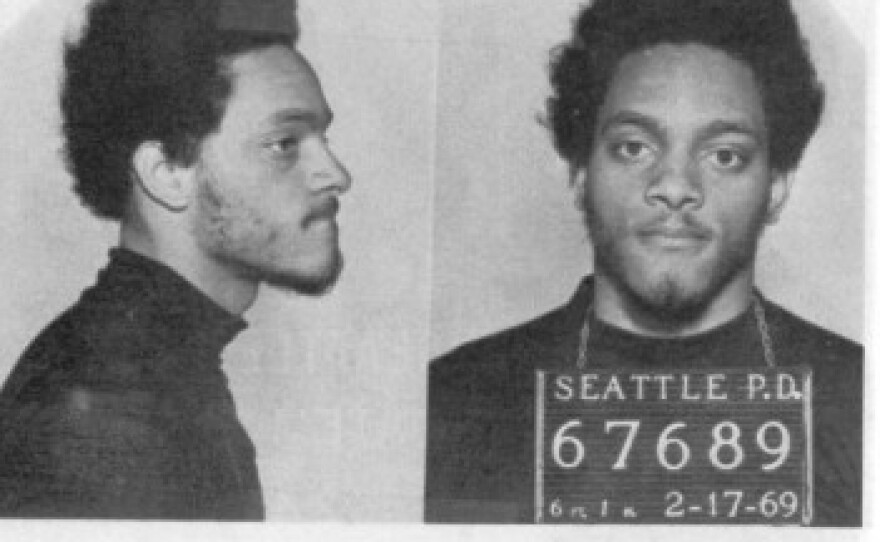Madrona is a posh Seattle neighborhood with million-dollar homes. But 50 years ago, at the playground here, it was where hundreds of Black Panthers trained.
The Panthers cut an intimidating profile in black berets and leather jackets. Among them was Elmer Dixon: “On any given Saturday, you could come up and see 300 to 400 Panthers up there and military formation drilling and training, and then we would march out of the park down 34th," he said. "All the way down Cherry to Garfield Park, where we would hold a rally."
It was 1968, the Civil Rights movement was in turmoil, and around the nation, young black activists were frustrated. When Martin Luther King was assassinated on April 4, 1968, Seattle was ripe for revolution.
At the time, brothers Elmer and Aaron Dixon were members of the Black Student Union. Aaron Dixon told the University of Washington's Seattle Civil Rights and Labor History Project that King's death changed everything.
“No longer did we feel that peaceful demonstrations was going to work," he said. "That we were now going to look toward other methods of demonstrating [for] getting our point across."
Just a short time after the assassination, the brothers formed the Seattle chapter of the Black Panther Party for Self Defense.
[asset-images[{"caption": "The People's Wall, painted by Dion Henderson, is shown on Wednesday, January 10, 2018, outside of the Seattle Black Panther Party's second office, near the intersection of East Spruce Street and 20th Avenue in Seattle.", "fid": "143585", "style": "placed_full", "uri": "public://201803/MF_SBPP04.jpg", "attribution": "Credit KUOW Photo/Megan Farmer"}]]But Elmer Dixon says they were also required by the party to be well-versed in the law. The Panther's 10-point program addressed safety, social needs and the oppression and incarceration of black people.
“We weren't anti-white," Dixon said. "We were anti-system. And a lot of people don't know that about the Black Panther Party. We had coalitions with every group. In fact, the phrase 'rainbow coalition' was coined by Fred Hampton, not by Jesse Jackson."
At the time, Seattle was perceived as a quiet Northwest town. But the reality was more politically volatile. Congressional records show there were more than 70 fire bombings between 1969 and 1970.
“I won't say that there weren't probably some Panthers that were involved in that," Dixon said. "Because it was hard to control 300 to 400 Panthers."
[asset-images[{"caption": "Elmer Dixon raises his fist in the air while speaking on Monday, January 15, 2018, during a rally at Garfield high school before the annual Martin Luther King Jr. Day march in Seattle. ", "fid": "143586", "style": "placed_full", "uri": "public://201803/MF_SBPP09.jpg", "attribution": "Credit KUOW Photo/Megan Farmer"}]]There was deep mistrust and numerous confrontations with police. Patrol cars used to park around the corner from Elmer Dixon's childhood home, an area he said was known as "Pork Chop Hill." His house, where his mother still lives today, was across the street from the playground where the Panthers trained. Today, a sculpture by Richard Beyer outside the Madrona library commemorates the era: a panther and a pig, along with a wolf and sheep.
Dixon recalled that on a summer day in 1968, police raided the Panther headquarters on 34th Avenue, looking for a stolen typewriter.
“I came around the corner and the whole street was full of police cars," he said. "There wasn't a spot that wasn't taken up. And that was the day they had arrested my brother and my brother-in-law Curtis Harris out of the office here for allegedly stealing the typewriter."
The raid sparked riots, and civilians and police were injured by rocks and gunfire. Both men were acquitted.
Fifity years later, Dixon stood outside the old Black Panther headquarters and remembered that a real estate agent shared the other side of the building. Given the city’s history of red-line housing discrimination (read more about that here), Dixon said, the real estate agent was uneasy.
“He spent very little time here," Dixon said. "I think he was afraid to death of us. And probably he was very happy when we finally decided to move."
By fall of 1968, the Panthers had moved their offices into a nearby house, which also became a free medical clinic.
These days Elmer Dixon is helps police departments and cities as a diversity consultant. The work brings him back to the playground where he grew up.
There was a little bit of everybody out here, he said. White kids, black kids, brown kids.
He's still trying to make sure there's room for them all. And at the end of April, there will be a conference to mark the 50th anniversary.
[asset-images[{"caption": "A sculpture of a panther and a pig is shown on what some call 'Porkchop Hill,' on Wednesday, January 10, 2018, at the intersection of E. Union Street and 33rd Avenue in Seattle. ", "fid": "143587", "style": "placed_full", "uri": "public://201803/MF_SBPP02.jpg", "attribution": "Credit KUOW Photo/Megan Farmer"}]]This piece was first published on March 30, 2018.




